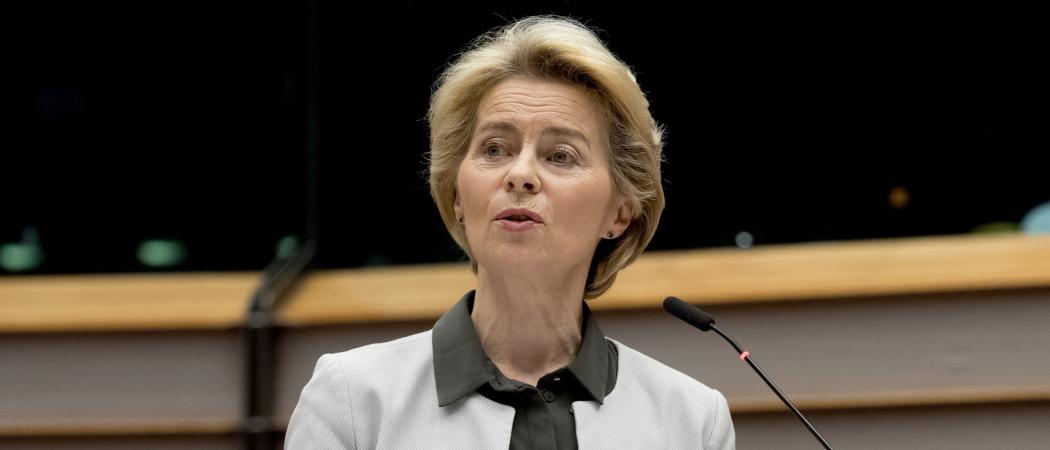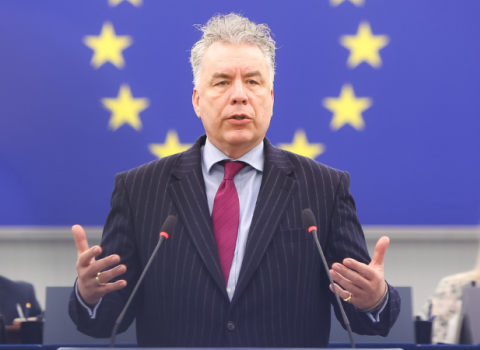It is ‘Europe’s man on the moon moment’, as Brussels unveils plan for climate neutrality by 2050. But the target is stirring tensions between richer member states in the west and the fossil fuel-dependent east

EU commission president Ursula von der Leyen presented the European Green Deal in the European Parliament. Photo: European Commission
The EU Council is meeting to consider the European Green Deal, a large scale re-imagining of how Europe’s economies can collectively create the first carbon-neutral continent by 2050.
The goal is a comprehensive makeover of all sectors of the economy in support of the ambition of reducing greenhouse gas emissions and avoiding the worst consequences of climate change.
"This is Europe’s man on the moon moment," said European Commission president Ursula von der Leyen, presenting the Green Deal on Wednesday, her first major proposal since taking office on 1 December.
The Green Deal is not a single project or piece of legislation, but a strategy that includes 50 specific policy measures.
In March 2020, the European Commission will propose a legal obligation to achieve net-zero greenhouse gas emissions by mid-century compared to 1990 levels. Following on from this, by the middle of 2020 it will set out a plan strengthen the EU’s greenhouse gas emission reductions target for 2030, from the current 40 per cent reduction to “at least” 50 per cent compared with 1990 levels.
Member states will have to present revised energy and climate plans to the commission by the end of 2019. “The commission will assess the ambition of the plans, and the need for additional measures if the level of ambition is not sufficient,” the plan says.
For now, it’s hard to pin down the exact cost of the Green Deal. It will require up to €260 billion of additional annual investments just to meet existing climate targets; the more ambitious ones will cost even more.
“Some say the cost of this transition is too high, let us never forget what the cost of non-action would be,” said von der Leyen. “It is rising by the year.”
Supporters of the pact say climate change could be equally costly to the European economy. The commission estimates climate change would eventually lead to 400,000 premature deaths per year due to air pollution, 90,000 deaths per year from heatwaves, and 600,000 additional asylum applications per year to Europe.
Brussels pledges the plan will cut emissions while also creating jobs. In March 2020, the commission will propose a new industrial strategy to address what it calls, “the twin challenge of the green and the digital transformation.”
The strategy will target “climate and resource frontrunners”, which will be the first commercial applications of breakthrough technologies in key industrial sectors. Priority areas mentioned in the plan include clean steel technologies, hydrogen, fuel cells and other alternative fuels, energy storage, and carbon capture, storage and utilisation.
The plan re-affirms the goal to dedicate at least 35 per cent of the EU’s 2021-2027 Horizon Europe programme to climate research.
Horizon Europe-funded partnerships between industry and governments will support research and innovation on batteries, hydrogen energy, low-carbon steel making and bio-based sectors.
Research missions will also have a particularly green direction. “We are working on [five] research missions – four of which will be very much linked to the green deal objectives, [including] healthy soils, healthy oceans and clean cities,” an EU official said.
Just transition
The EU plan also says that change can’t just be a technological feat, and must tackle poverty and income inequality.
Reflecting this, a major component is a ‘Just Transition Mechanism’ to provide job training and promote development of new industrial sectors in countries that rely on jobs in fossil fuel industries.
Von der Leyen said the commission wants to mobilise €100 billion of investment overall to help EU economies pay for the transition away from fossil fuels.
The plan follows recent dire warnings from scientists about the impacts on the planet of a temperature rise of two degrees Celsius this century.
It is “a message of intent to the rest of the world,” says Quentin Genard, Brussels head of E3G, a climate change think tank.
Variations of the plan have been around for years, but it was popularised most recently in the US by two Democrats: representative Alexandria Ocasio-Cortez of New York and senator Edward Markey of Massachusetts. Their Green New Deal proposal echoes the New Deal, launched by president Franklin D. Roosevelt to help the US recover from the Great Depression.
Ambition meets reality
Little doubt the plan is high on ambition but is it practical?
“There will also be heavy ‘yes, but’ lobbying from incumbent industries, as well as the usual political games from member states and parliamentary groups when agreements are sought,” said Genard.
The environmental pressure group Friends of the Earth Europe said the plan, “marks a major change in tone”, but “doesn’t go far enough”.
“We’re on a runaway train to ecological and climate collapse and the commission is gently switching gears instead of slamming on the brakes,” said Jagoda Munić, director of the group.
The plan is stirring tensions between the richer and greener western half of the continent and the poorer, fossil fuel-dependent east. Czech prime minister Andrej Babis struck a hesitant tone on Twitter. “The Czech Republic also wants to reach carbon neutrality, but we won’t make it without nuclear. The EU must recognise nuclear as emission-free source,” he said. “On the top of that, the costs of carbon neutrality will be huge.”
Some others were even more dismissive. “More regulation. More spending. More taxes. More top-down control. Picking winners in a complex technological environment. What could possibly go wrong?” tweeted Pieter Cleppe, head of the Brussels office of the Open Europe think tank.
According to the plan, transport needs to be almost completely overhauled if climate neutrality by 2050 is to happen. Observers say this would be incredibly difficult to achieve without some major technology advances.
The plan looks set to command broad support in Brussels, but the commission warns it won’t be enough on its own to tilt the world away from dangerous climate change.
“As long as many international partners do not share the same ambition as the EU, there is a risk of carbon leakage, either because production is transferred from the EU to other countries with lower ambition for emission reduction, or because EU products are replaced by more carbon-intensive imports,” the EU says.





 A unique international forum for public research organisations and companies to connect their external engagement with strategic interests around their R&D system.
A unique international forum for public research organisations and companies to connect their external engagement with strategic interests around their R&D system.